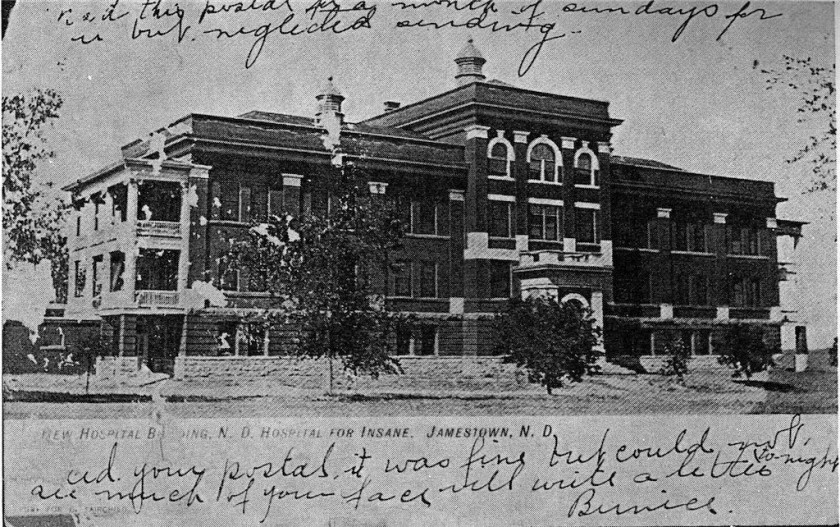News and Events
North Dakota’s 140-year-old State Hospital gets $300M green light for rebuild
Posted 5/20/25 (Tue)

A main building of the Jamestown State Hospital, formeryly known as the "North Dakota Hospital for the insane," when it was first built at the end of the 19th century. Contributed / North Dakota State Hospital History and Museum project.
By Peyton Haug - Forum Communications
BISMARCK — North Dakota’s 140-year-old State Hospital in Jamestown is getting more than a facelift after the Legislature doled out $300 million to build a brand-new facility, part of an effort to improve access to and quality of mental health care statewide.
Throughout its complex and at times dark history, the facility has offered varying forms of psychiatric care and substance abuse rehabilitation since its doors opened in 1885.
“Let’s face it, the facility up there is aged, and there are efficiencies that come with a modern facility,” said Jamestown Mayor Dwaine Heinrich.
He called the project a “positive” change for the town.
Because the hospital is uniquely bound by the state constitution to be located in Jamestown, the facility has come to define many aspects of the community — from establishing a legacy workforce to forming ties to the local university.
Pam Sagness attended the University of Jamestown and is now the director of the Department of Health and Human Services’ Behavioral Health Division.
“I talk a lot about how we provide not just specialty care, but also public safety,” Sagness said, pointing to the hospital’s segregated sex offender unit.
Today, people staying at the State Hospital are often court-ordered to be there and stay for 72 days on average. Some are there for decades, according to the state Department of Health and Human Services.
Sagness has been working closely with the hospital’s staff, the Legislature, architects and construction managers to develop the plan for the new facility, which will have 140 beds — 18 more than that of the existing campus. The original plan accounted for 164 beds but was over budget by $32 million.
The 30-acre campus will be developed across the street from the current facility, which will be handed to the Department of Corrections and Rehabilitation.
Up until last growing season, the adjacent state-owned land was leased out to a farmer for growing crops. According to Mike Van Klei, one of the project’s architecture consultants, the farmer has been notified of the project and “shouldn’t be surprised” by the change in land use.
The building itself will be about 300,000 square feet — a little more than half the size of the existing State Hospital space. It will be equipped with more amenities like walking paths and courtyards, as well as added safety features and single-occupancy rooms.
Modernizing the facility will make it trauma-informed and more efficient, Sagness said, as workers will spend less time traveling across campus, and new appliances will save on energy costs. The efficiency will also mitigate the need for more hospital staff, she added.
According to the State Historical Society, over 1,200 patients have been housed at the campus at one time. Patients, who in the early 20th century worked with staff to raise crops and livestock to make the hospital self-sufficient, would be piled into attics and barns to sleep.
After national psychiatric care standards improved and behavioral health clinics opened across the state, admissions have fallen to approximately 10% of that figure.
Part of the campus has since been converted for the James River Correctional Center.
Separating the hospital from the prison destigmatizes its purpose and “makes it clear” there’s a difference between each facility, Heinrich said.
Deb Eissinger, a registered nurse who is the hospital’s director of quality, has contributed to the planning process and is one of several staffers with generational ties to the hospital.
She remembers being “scared to death” of the vast, gloomy buildings when she would visit her grandparents who worked in the hospital in the 1960s.
That time was a turning point for the hospital as regulators stepped in and demanded reform.
“Gone are the cages, strait jackets, leg irons, stern guards, malnutrition, windowless seclusion rooms, unorganized departments, the sixty-hour work week, the naked despondent patient on a back ward, the odors from wards crammed with untidy and helpless men and women,” read a 1958 report to the Legislature, according to the State Historical Society.
Eissinger’s fears of the hospital fully dissipated when she graduated from the University of Jamestown in the 1980s and decided to pursue a career in behavioral health, following in her grandparents’ footsteps. She hasn’t worked anywhere else since.
“It’s a good place to work,” she said. “We see people that get better, people that are struggling.”
She describes the staff as a “big family” excited for a new campus.
Construction is expected to begin around early August and be completed in August 2028. According to project managers, the number of workers needed will vary, with 300 to 350 on site during the project’s peak.
Where those workers will come from depends on the outcome of the upcoming bidding process. Such an influx can bring challenges to the city of just over 15,000 people, Heinrich said, and he is not expecting the State Hospital project to be any different.
“Whatever the challenges, they will be overcome,” he said. “The end result will be well worth the effort.”